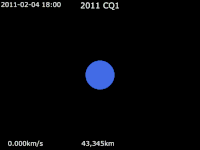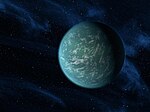astro.wikisort.org - Asteroid
2011 CQ1 is a meteoroid discovered on 4 February 2011 by Richard A. Kowalski, at the Catalina Sky Survey.[1] On the same day the meteoroid passed within 0.85 Earth radii (5,480 kilometers (3,410 mi)) of Earth's surface, and was perturbed from the Apollo class to the Aten class of near-Earth objects.[5] With a relative velocity of only 9.7 km/s,[2] had the asteroid passed less than 0.5 Earth radii from Earth's surface, it would have fallen as a brilliant fireball. The meteoroid is between 80 centimeters (31 in) and 2.6 meters (100 in) wide.[5] The meteoroid was removed from the Sentry Risk Table on 5 February 2011.[6]
| Parameter | Epoch | aphelion (Q) |
perihelion (q) |
Semi-major axis (a) |
eccentricity (e) |
Period (p) |
inclination (i) |
Longitude ascending node (Ω) |
Mean anomaly (M) |
Argument of perihelion (ω) |
|---|---|---|---|---|---|---|---|---|---|---|
| Units | AU | (days) | (°) | |||||||
| Pre-flyby | 2011-Jan-26 | 1.347 | 0.9096 | 1.128 | 0.1940 | 437.9 | 1.073° | 135.4° | 310.9° | 58.59° |
| Post-flyby | 2011-Feb-08 | 1.009 | 0.6624 | 0.8360 | 0.2076 | 279.2 | 5.296° | 315.4° | 220.6° | 335.1° |
| Discovery[1] | |
|---|---|
| Discovered by | Catalina Sky Survey Richard A. Kowalski |
| Discovery date | 4 February 2011 |
| Designations | |
MPC designation | 2011 CQ1 |
Minor planet category |
|
| Orbital characteristics[2] | |
| Epoch 13 January 2016 (JD 2457400.5) | |
| Uncertainty parameter 5 | |
| Observation arc | 12.4 hours[3] (35 observations used) |
| Aphelion | 1.0087 AU (150.90 Gm) (Q) |
| Perihelion | 0.66454 AU (99.414 Gm) (q) |
Semi-major axis | 0.83661 AU (125.155 Gm) (a) |
| Eccentricity | 0.20567 (e) |
Orbital period (sidereal) | 0.77 yr (279.5 d) |
Mean anomaly | 18.607° (M) |
Mean motion | 1.2880°/day (n) |
| Inclination | 5.2445° (i) |
Longitude of ascending node | 315.23° (Ω) |
Argument of perihelion | 335.40° (ω) |
| Earth MOID | 0.000166307 AU (24,879.2 km) |
| Jupiter MOID | 4.09715 AU (612.925 Gm) |
| Physical characteristics | |
| Dimensions | ~1 meter (39 in) |
Apparent magnitude | 14.2 (2011 peak)[4] |
Absolute magnitude (H) | 32.1[2] |
It was not until 2020 QG on 16 August 2020 that a non-impacting closer approach to Earth was observed.
Animation of 2011 CQ1's orbit - 2011 flyby

Around the Sun

Around the Earth
Sun · 2011 CQ1 · Earth
See also
| Asteroid | Date | Distance from surface of Earth |
Uncertainty in approach distance |
Reference |
|---|---|---|---|---|
| 2020 VT4 | 2020-11-13 | 374 km | ±25 km | data |
| 2020 QG | 2020-08-16 | 2946 km | ±20 km | data |
| 2021 UA1 | 2021-10-25 | 3047 km | ±20 km | data |
| 2011 CQ1 | 2011-02-04 | 5481 km | ±5 km | data |
| 2019 UN13 | 2019-10-31 | 6242 km | ±200 km | data |
| 2008 TS26 | 2008-10-09 | 6259 km | ±1000 km | data |
| 2004 FU162 | 2004-03-31 | 6542 km | ±15000 km | data |
References
- "MPEC 2011-C12 : 2011 CQ1". IAU Minor Planet Center. 4 February 2011. Retrieved 27 February 2013. (K11C01Q)
- "JPL Close-Approach Data: (2011 CQ1)" (last observation: 2011-02-04; arc: 1 day). Archived from the original on 28 June 2021. Retrieved 31 March 2016.
- "2011 CQ1". Minor Planet Center. Retrieved 21 August 2020.
- "2011 CQ1 Ephemerides for 4 February 2011". NEODyS (Near Earth Objects – Dynamic Site). Retrieved 28 February 2013.
- Don Yeomans & Paul Chodas (4 February 2011). "Very Small Asteroid Makes Close Earth Approach on 4 February 2011". News. NASA/JPL Near-Earth Object Program Office. Archived from the original on 2 September 2011. Retrieved 18 September 2011.
- "Date/Time Removed". NASA/JPL Near-Earth Object Program Office. Archived from the original on 2 June 2002. Retrieved 19 March 2012.
External links
- Tiny Asteroid Zips Close By Earth space.com 6 February 2011
- Asteroid makes sharpest turn yet seen in solar system New Scientist 9 February 2011
- Asteroid's Record-Breaking Brush with Earth Changed It Forever Space.com 23 February 2011
- 2011 CQ1 at NeoDyS-2, Near Earth Objects—Dynamic Site
- Ephemeris · Obs prediction · Orbital info · MOID · Proper elements · Obs info · Close · Physical info · NEOCC
- 2011 CQ1 at ESA–space situational awareness
- 2011 CQ1 at the JPL Small-Body Database
На других языках
[de] 2011 CQ1
2011 CQ1 ist ein erdnaher Kleinkörper des Sonnensystems.- [en] 2011 CQ1
Текст в блоке "Читать" взят с сайта "Википедия" и доступен по лицензии Creative Commons Attribution-ShareAlike; в отдельных случаях могут действовать дополнительные условия.
Другой контент может иметь иную лицензию. Перед использованием материалов сайта WikiSort.org внимательно изучите правила лицензирования конкретных элементов наполнения сайта.
Другой контент может иметь иную лицензию. Перед использованием материалов сайта WikiSort.org внимательно изучите правила лицензирования конкретных элементов наполнения сайта.
2019-2025
WikiSort.org - проект по пересортировке и дополнению контента Википедии
WikiSort.org - проект по пересортировке и дополнению контента Википедии


